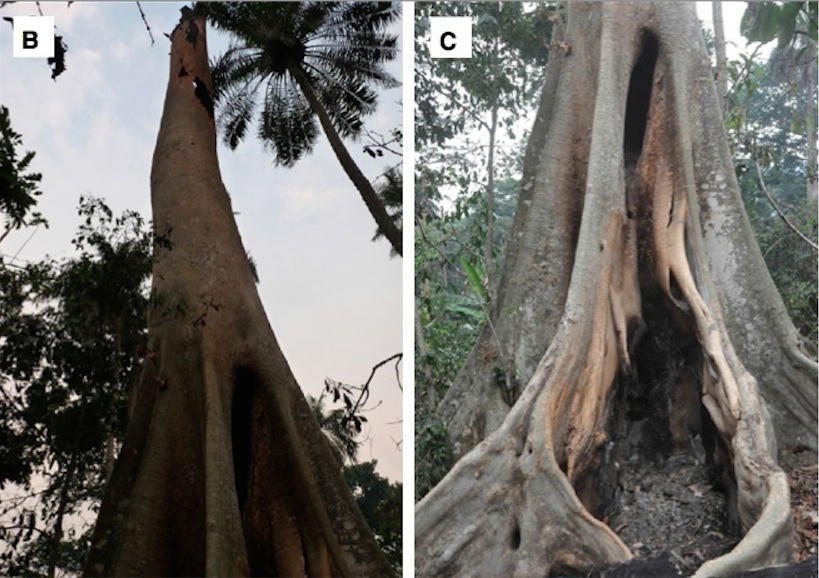Bat-Filled Tree May Have Been Source of Current Ebola Outbreak

In the small village of Meliandou, in Guinea, stood a tall, hollowed-out tree where children loved to play. But thousands of bats lived in the tree, and one toddler — a 2-year-old named Emile Ouamouno — may have contracted Ebola from playing there.
Emile, who died in December 2013, was "patient zero," or the first person known to have contracted Ebola in the current outbreak that has now claimed at least 7,600 lives in the region. In a new study, researchers looking for the source of the outbreak found that free-tailed bats (Mops condylurus) lived in the tree. These bats are likely a reservoir of the disease, the researchers concluded.
The tree was about 165 feet (50 meters) away from Emile's house, in the village of 31 houses surrounded by farmland.
"It [the tree] was near a path where the women would go for washing," said Fabian Leendertz, a veterinarian at the Robert Koch Institute in Germany who specializes in zoonotic diseases. "They would always walk down there with the kids, and the kids would play in this nice tree." [Where Did Ebola Come From?]
Perhaps Emile got Ebola from one of the bats in the tree, Leendertz told Live Science.
The researchers will never know for sure — a fire in the tree on March 24 killed thousands of bats. A few days later, when Leendertz and his team arrived in the village, the villagers had already removed or eaten the dead bats, and there wasn't any evidence left to test for the Ebola virus, Leendertz said. However, the team did find DNA evidence that Mops condylurus were living there, he said.
The finding opens up the possibility that free-tailed bats, which eat insects, may carry and transmit Ebola, reports the study, published today (Dec. 30) in the journal EMBO Molecular Medicine. Other studies have found that the virus can live in fruit-eating and insect-eating bats, Leendertz said.
Sign up for the Live Science daily newsletter now
Get the world’s most fascinating discoveries delivered straight to your inbox.

Leendertz and his colleagues spent four weeks surveying the forest around Meliandou and interviewing villagers in the area. One theory is that Emile could have caught Ebola from a large mammal, such as a chimpanzee, but the researchers found no evidence of an Ebola outbreak in nearby animals.
"Animals, we can largely rule out," Leendertz said. "In theory, there could have been a small hidden epidemic. We didn't monitor the entire forest, but we can for sure say there was no large epidemic among the large wildlife."
Moreover, regional authorities, hunters and women in the village told the researchers that primates are rare in this region of southeastern Guinea, and the few that remain are difficult to hunt. Much of the large game eaten in the area arrives smoked from Liberia and northwestern Guinea, which makes it an unlikely source of the disease, the researchers said.
It is also possible to get Ebola from eating improperly cooked bat meat or by coming in contact with infected bodily fluids from a bat — and villagers in Meliandou routinely hunt bats for food. The researchers captured 169 bats in the area and tested them for Ebola, but none of the tests came back positive, Leendertz said. However, a foodborne transmission of Ebola likely would have affected adults in the community before or at the same time it affected Emile, the researchers said. This suggests a source of infection unrelated to food.
Many of the children in the village caught and played with bats in the hollow tree, and it remains possible that Emile caught Ebola there, Leendertz said.
"People have said, 'How can you be sure that the boy played in the tree?'" Leendertz said. "But how likely is it that a kid would not play in a playground next to his house? We talked a lot to the other children, and found out that they are actually quite big bat hunters."
It's not clear how the tree caught fire, but it burned down soon after the Guinea government banned the eating and hunting of bats, Leendertz said. He stressed that bats play an important role in the region's ecosystem: Fruit bats pollinate flowers and spread seeds, and insectivorous bats eat mosquitoes and help prevent the spread of malaria.
"We have to learn to live with these animals like we live with rabies in bats in Germany and Europe," he said. "It's not a solution to start killing bats and chasing away the colonies."
Follow Laura Geggel on Twitter @LauraGeggel. Follow Live Science @livescience, Facebook & Google+. Original article on Live Science.

Laura is the archaeology and Life's Little Mysteries editor at Live Science. She also reports on general science, including paleontology. Her work has appeared in The New York Times, Scholastic, Popular Science and Spectrum, a site on autism research. She has won multiple awards from the Society of Professional Journalists and the Washington Newspaper Publishers Association for her reporting at a weekly newspaper near Seattle. Laura holds a bachelor's degree in English literature and psychology from Washington University in St. Louis and a master's degree in science writing from NYU.










